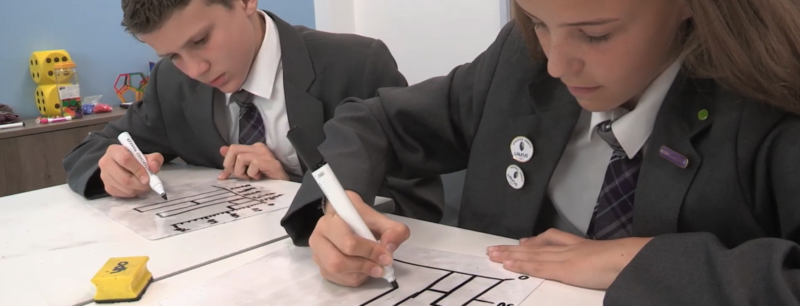How are RME classrooms different?
RME classrooms promote a culture of listening, observing, and refining mathematical techniques.
Our materials are designed to support students to build mathematical ideas for themselves. But, teachers have an important role in fostering this process. Supporting students in refining their initial informal strategies into a deep understanding of formal mathematics is not straightforward.
To make this happen, RME teachers aim to develop a classroom environment where students are expected to explain their ideas to others, and to listen and respond to what other students say. This means that RME classrooms can look and sound quite different from other mathematics classrooms.

RME classrooms spend a lot of time talking about context.
Teachers and students working with RME will often discuss familiar scenarios—such as ordering a take-away or hunting for bargains on a shopping trip. Sometimes this discussion can be quite non-mathematical. But flushing out the detail of students’ experiences encourages them to model these contexts in ways that make sense to them. These informal ideas form the basis of later understanding, and teachers will spend time generating and discussing students’ representations of a context. This approach hugely benefits lower attainers. However, it also makes space for higher attaining students to extend their understanding, make connections between mathematical ideas, and practice explaining their ideas.
RME classrooms emphasize diagrams and drawings.
RME builds on students’ informal strategies for solving problems, and encourages them to draw what they know about a context in order to model it mathematically. Abstract formulae will eventually appear, but students will understand where these come from and will not need to rely on memory. RME provides students with a connection between rules and algorithms and the original contexts from which they were generated.

Students work at the board often.
Students are often invited (and volunteer) to go to the board to demonstrate strategies and arguments, and to share, question and explain. This might include talking about their strategies for solving even apparently straightforward questions. RME focuses on building students’ understanding of fundamental ideas, so that they have foundations on which to build solutions to more complex problems.
Teachers “listen in” to what students are talking about…..
To support students in developing their arguments, teachers move around the class, taking time to understand how they are thinking about a problem. Students will have a variety of approaches, strategies and explanations, and teachers make decisions about how these can be used to promote classroom discussion.
… and select strategies to discuss with the whole class.
 Teachers sometimes choose to show a variety of strategies themselves and ask the class what they think. Their questions are frequently open, not closed. Here, the teacher might ask “What is different, what is the same?”
Teachers sometimes choose to show a variety of strategies themselves and ask the class what they think. Their questions are frequently open, not closed. Here, the teacher might ask “What is different, what is the same?”
Alternatively, they may choose students to demonstrate a strategy at the board. Teachers will frequently move to the back of the class at this point, giving students the floor.
Students may take over the discussion.
Once they are at the board, students will often discuss with each other and by-pass the teacher. The teacher’s role is to facilitate a productive discussion, making sure that students explain clearly and listen to each other. They may also help out by suggesting that students go back to the context and remind themselves of what they are trying to do.

There are a number of challenges for teachers in RME classrooms, not least how they will keep an eye on the ‘mathematical horizon’—where they want their students to go. How can the discussion include all students? What to do about misconceptions? Where are students headed mathematically?

